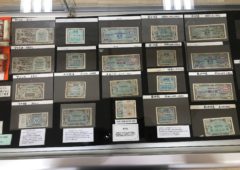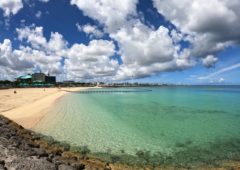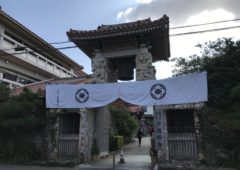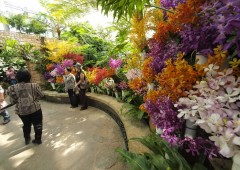2014.08.27
“Shinto Abe” the “Tenno Message” and the Third Alternative for “Our Okinawa Ocean”
Protests rage on in the Henoko District of Nago City where the “soil boring sample” tests have begun. Japan Coast Guard cutters are off shore, as mother ships to patrol zodiacs buzzing around the buoy circled “off limits” area ready to remove protesters on kayaks and fishing boats. I would like to visit to see for myself, and will report next week in this opinion column.
I remember when, just before we co-founded the Okinawa Clean Coast Network (OCCN) with our friends at the 11th Division Headquarters of the Japan Coast Guard, they showed their support for protecting “Our Okinawa Ocean” by sending the JCG cutter “Kudaka” to Cape Maeda, where rescue divers arrived in their special boat to join us in the beach and underwater cleanup. We can pick up marine litter but we cannot restore the ocean a landfill.
This past June, Secretary of State John Kerry brought together leaders in business, science and government looking at how to best protect our planet’s blue heart with strategy sessions to “communicate the benefits of our ocean and coasts and the risks to coastal communities if we do not sustain these valuable assets including how the health of the ocean and coasts is linked to economic security, food security, human health, and the resilience of coastal communities worldwide.” The landfill of “Oura Bay” under democratic duress was not on the agenda.
There is a third alternative, which was presented under former PM Hatoyama’s cabinet. According to the Japan Times story July 29th, 2014 by Tai Kawabata: “Military analyst Kazuhisa Ogawa says that he has a plan that could solve the Futenma base mess in just two days.” highlighted by the core to his plan: “The main component of Ogawa’s plan is to construct a permanent airfield with a 2,500-meter-long runway, slightly shorter than Futenma’s 2,800-meter-long runway, by redeveloping the former Chimu airfield inside Camp Hansen in the central part of Okinawa Island and close to the island’s east coast. The U.S. Army built Chimu airfield in April 1945 with a 1,520-meter runway in just 10 days, but it has since fallen into disuse.
A recently published white paper by a Washington D.C. think tank (details on-line version) warn that heavy handed policies against Okinawa will most likely create increased opposition to the US military/Japan plans for Henoko.
It is well documented that Japan’s current Prime Minister Shinzo Abe, is supportive of restoring Shinto to prominence in Japanese society with a strong push towards prewar values.
http://www.greenshinto.com/wp/2013/08/16/shinto-and-the-right-wing/
On April 28th last year, the Japanese Government of Shinzo Abe held a ceremony titled: “Anniversary of Japan’s Restoration of Sovereignty and Return to the International Community”. It celebrated the end of the US led occupation of Japan in 1952 while Amami Islands and Okinawa remained under US administration. This day was deemed as a “Day of Insult” in Okinawa.
Towards the end of the ceremony, PM Abe led the public in a “Tenno Banzai” (long live the Emperor) cheer. Their Majesties Emperor Akihito and Empress Michiko were both caught off guard and visibly startled as they left the stage.
Perhaps it is up to His Majesty the Emperor to suggest a third alternative. His father Emperor Hirohito seems to have sealed Okinawa’s fate leading to today’s conflicts with the opinions he gave General MacArthur concerning the “Future of the Ryukyu Islands”.
Is this “Tenno Message” from 1947 the foundation of the Prime Minister’s road map for Okinawa?
As a devout believer in Shinto, would the present Emperor His Majesty Akihito ever have a chance to comment on this while the “Imperial Household Council” is chaired by PM Abe?
This connection to these memos perhaps lingers on as we find the “Shinto” Torii gates emblazoned in the US Forces in Okinawa and Japan. This was pointed out to me by an elderly Okinawa statesman.
The documents are available in the US National Archives according to the excellent book by Robert D. Eldridge:
The Origins of the Bilateral Okinawa Problem: Okinawa in Postwar US-Japan …
Of further reading and interest, the recent http://www.aropeintheopensea.com/ and of course the great resource: John Purves Contemporary Okinawa http://www.niraikanai.wwma.net/pages/site.html
“Emperor of Japan’s Opinion Concerning the Future of the Ryukyu Islands”
Tokyo, September 22, 1947
UNITED STATES POLITICAL ADVISER FOR JAPAN Tokyo, September 22, 1947.
Subject: Emperor of Japan’s Opinion Concerning the Future of the Ryukyu Islands.
The Honorable, The Secretary of State, Washington.
Sir: I have the honor to enclose copy of a self-explanatory memorandum for General MacArthur, September 20, 1947, containing the gist of a conversation with Mr. Hidenari Terasaki, an adviser to the Emperor, who called at this Office at his own request. It will be noted that the Emperor of Japan hopes that the United States will continue the military occupation of Okinawa and other islands of the Ryukyus, a hope, which undoubtedly is largely based upon self-interest.
The Emperor also envisages a continuation of United States military occupation of these islands through the medium of a long-term lease. In his opinion, the Japanese people would thereby be convinced that the United States has no ulterior motives and would welcome United States occupation for military purposes.
Respectfully yours, W. J. Sebald Counselor of Mission
Enclosure to Dispatch No. 1293 dated September 22, 1947,
from the United States Political Adviser for Japan, Tokyo, on the subject “Emperor of Japan’s Opinion Concerning the Future of the Ryukyu Islands
“ General Headquarters,
Supreme Commander for the Allied Powers Diplomatic Section ,
20 September, 1947
Memorandum For: General MacArthur
Mr. Hidenari Terasaki, an adviser to the Emperor, called by appointment for the purpose of conveying to me the Emperor’s ideas concerning the future of Okinawa.
Mr. Terasaki stated that the Emperor hopes that the United States will continue the military occupation of Okinawa and other islands of the Ryukyus. In the Emperor’s opinion, such occupation would benefit the United States and a1so provide protection for Japan. The Emperor feels that such a move would meet with widespread approval among the Japanese people who fear not only the menace of Russia, but after the Occupation has ended, the growth of rightist and leftist groups, which might give rise to an “incident,” which Russia could use as a basis for interfering internally in Japan.
The Emperor further feels that United States military occupation of Okinawa (and such other islands as may be required) should be based upon the fiction of a long-term lease — 25 to 50 years or more — with sovereignty retained in Japan. According to the Emperor, this method of occupation would convince the Japanese people that the United States has no permanent designs on the Ryukyu Islands, and other nations, particularly Soviet Russia and China, would thereby be stopped from demanding similar rights.
As to procedure, Mr. Terasaki felt that the acquisition of “military base rights” (of Okinawa and other islands in the Ryukyus) should be by bilateral treaty between the United States and Japan rather than form part of the Allied peace treaty with Japan. The latter method, according to Mr. Terasaki, would savor too much of a dictated peace and might in the future endanger the sympathetic understanding of the Japanese people.
W. J. Sebald
Comments welcome to edo@okinawaocean.or


 2024.06.08
2024.06.08 2024.05.25
2024.05.25 2024.04.26
2024.04.26 2024.04.22
2024.04.22 2024.04.10
2024.04.10 2024.01.31
2024.01.31 2024.01.02
2024.01.02 2023.12.27
2023.12.27 2023.11.16
2023.11.16






